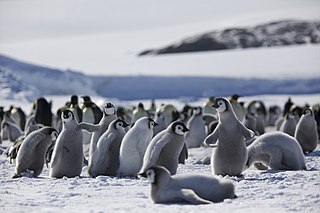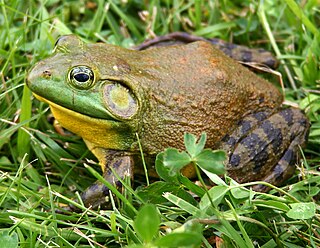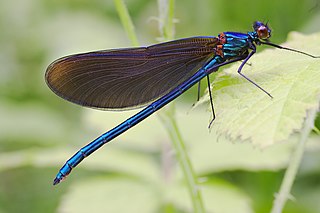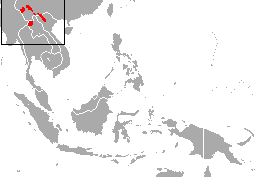Related Research Articles

Sexual dimorphism is the condition where the sexes of the same animal and/or plant species exhibit different morphological characteristics, particularly characteristics not directly involved in reproduction. The condition occurs in most animals and some plants. Differences may include secondary sex characteristics, size, weight, color, markings, or behavioral or cognitive traits. Male–male reproductive competition has evolved a diverse array of sexually dimorphic traits. Aggressive utility traits such as “battle” teeth and blunt heads reinforced as battering rams are used as weapons in aggressive interactions between rivals. Passive displays such as ornamental feathering or song-calling have also evolved mainly through sexual selection. These differences may be subtle or exaggerated and may be subjected to sexual selection and natural selection. The opposite of dimorphism is monomorphism, when both biological sexes are phenotypically indistinguishable from each other.

Behavioral ecology, also spelled behavioural ecology, is the study of the evolutionary basis for animal behavior due to ecological pressures. Behavioral ecology emerged from ethology after Niko Tinbergen outlined four questions to address when studying animal behaviors: What are the proximate causes, ontogeny, survival value, and phylogeny of a behavior?

The European pied flycatcher is a small passerine bird in the Old World flycatcher family. One of the four species of Western Palearctic black-and-white flycatchers, it hybridizes to a limited extent with the collared flycatcher. It breeds in most of Europe and across the Western Palearctic. It is migratory, wintering mainly in tropical Africa. It usually builds its nests in holes on oak trees. This species practices polygyny, usually bigamy, with the male travelling large distances to acquire a second mate. The male will mate with the secondary female and then return to the primary female in order to help with aspects of child rearing, such as feeding.

The American bullfrog, often simply known as the bullfrog in Canada and the United States, is a large true frog native to eastern North America. It typically inhabits large permanent water bodies such as swamps, ponds, and lakes. Bullfrogs can also be found in man made habitats such as pools, koi ponds, canals, ditches and culverts. The bullfrog gets its name from the sound the male makes during the breeding season, which sounds similar to a bull bellowing. The bullfrog is large and is commonly eaten throughout its range, especially in the southern United States where they are plentiful.

In ethology, territory is the sociographical area that an animal consistently defends against conspecific competition using agonistic behaviors or real physical aggression. Animals that actively defend territories in this way are referred to as being territorial or displaying territorialism.
A mating system is a way in which a group is structured in relation to sexual behaviour. The precise meaning depends upon the context. With respect to animals, the term describes which males and females mate under which circumstances. Recognised systems include monogamy, polygamy, and promiscuity, all of which lead to different mate choice outcomes and thus these systems affect how sexual selection works in the species which practice them. In plants, the term refers to the degree and circumstances of outcrossing. In human sociobiology, the terms have been extended to encompass the formation of relationships such as marriage.

Sperm competition is the competitive process between spermatozoa of two or more different males to fertilize the same egg during sexual reproduction. Competition can occur when females have multiple potential mating partners. Greater choice and variety of mates increases a female's chance to produce more viable offspring. However, multiple mates for a female means each individual male has decreased chances of producing offspring. Sperm competition is an evolutionary pressure on males, and has led to the development of adaptations to increase males' chance of reproductive success. Sperm competition results in a sexual conflict of interest between males and females. Males have evolved several defensive tactics including: mate-guarding, mating plugs, and releasing toxic seminal substances to reduce female re-mating tendencies to cope with sperm competition. Offensive tactics of sperm competition involve direct interference by one male on the reproductive success of another male, for instance by physically removing another male's sperm prior to mating with a female. For an example, see Gryllus bimaculatus.

A harem is an animal group consisting of one or two males, a number of females, and their offspring. The dominant male drives off other males and maintains the unity of the group. If present, the second male is subservient to the dominant male. As juvenile males grow, they leave the group and roam as solitary individuals or join bachelor herds. Females in the group may be inter-related. The dominant male mates with the females as they become sexually active and drives off competitors, until he is displaced by another male. In some species, incoming males that achieve dominant status may commit infanticide.

The Calopterygidae are a family of damselflies, in the suborder Zygoptera. They are commonly known as the broad-winged damselflies, demoiselles, or jewelwings. These rather large damselflies have wingspans of 50–80 mm, are often metallic-coloured, and can be differentiated from other damselflies by the broader connection between the wings and the body, as opposed to the abrupt narrowing seen in other damselfly families. The family contains some 150 species.
Monogamous pairing in animals refers to the natural history of mating systems in which species pair bond to raise offspring. This is associated, usually implicitly, with sexual monogamy.

Display behaviour is a set of ritualized behaviours that enable an animal to communicate to other animals about specific stimuli. These ritualized behaviours can be visual however many animals depend on a mixture of visual, audio, tactical and/or chemical signals as well. Evolution has tailored these stereotyped behaviours to allow animals to communicate both conspecifically and interspecifically which allows for a broader connection in different niches in an ecosystem. It is connected to sexual selection and survival of the species in various ways. Typically, display behaviour is used for courtship between two animals and to signal to the female that a viable male is ready to mate. In other instances, species may exhibit territorial display behaviour, in order to preserve a foraging or hunting territory for its family or group. A third form is exhibited by tournament species in which males will fight in order to gain the 'right' to breed. Animals from a broad range of evolutionary hierarchies avail of display behaviours - from invertebrates such as the simple jumping spider to the more complex vertebrates like the harbour seal.

The black crested gibbon is a Critically Endangered species of gibbon found in China, Laos, and northern Vietnam, with four subspecies.

A courtship display is a set of display behaviors in which an animal, usually a male, attempts to attract a mate; the mate exercises choice, so sexual selection acts on the display. These behaviors often include ritualized movement ("dances"), vocalizations, mechanical sound production, or displays of beauty, strength, or agonistic ability.

The polygyny threshold model is an explanation of polygyny, the mating of one male of a species with more than one female. The model shows how females may gain a higher level of biological fitness by mating with a male who already has a mate. The female makes this choice despite other surrounding males because the choice male's genetics, territory, food supply, or other important characteristics are better than those of his competitors, even with two females on the territory.

Anthidium manicatum, commonly called the European wool carder bee is a species of bee in the family Megachilidae, the leaf-cutter bees or mason bees.

Anthidium maculosum is a species of bee in the family Megachilidae, the leaf-cutter, carder, or mason bees. It is a solitary bee where the males are territorial and the females take part in polyandry. The males of A. maculosum differ from most other males of bee species because the males are significantly larger than females. In addition, subordinate males that act as satellites are smaller than territory-owning males. This species can be found predominately in Mexico and the United States.
Polygyny is a mating system in which one male lives and mates with multiple females but each female only mates with a single male. Systems where several females mate with several males are defined either as promiscuity or polygynandry. Lek mating is frequently regarded as a form of polygyny, because one male mates with many females, but lek-based mating systems differ in that the male has no attachment to the females with whom he mates, and that mating females lack attachment to one another.

Sexual selection in birds concerns how birds have evolved a variety of mating behaviors, with the peacock tail being perhaps the most famous example of sexual selection and the Fisherian runaway. Commonly occurring sexual dimorphisms such as size and color differences are energetically costly attributes that signal competitive breeding situations. Many types of avian sexual selection have been identified; intersexual selection, also known as female choice; and intrasexual competition, where individuals of the more abundant sex compete with each other for the privilege to mate. Sexually selected traits often evolve to become more pronounced in competitive breeding situations until the trait begins to limit the individual's fitness. Conflicts between an individual fitness and signaling adaptations ensure that sexually selected ornaments such as plumage coloration and courtship behavior are “honest” traits. Signals must be costly to ensure that only good-quality individuals can present these exaggerated sexual ornaments and behaviors.

In behavioral ecology, polyandry is a class of mating system where one female mates with several males in a breeding season. Polyandry is often compared to the polygyny system based on the cost and benefits incurred by members of each sex. Polygyny is where one male mates with several females in a breeding season . A common example of polyandrous mating can be found in the field cricket of the invertebrate order Orthoptera. Polyandrous behavior is also prominent in many other insect species, including the red flour beetle and the species of spider Stegodyphus lineatus. Polyandry also occurs in some primates such as marmosets, mammal groups, the marsupial genus' Antechinus and bandicoots, around 1% of all bird species, such as jacanas and dunnocks, insects such as honeybees, and fish such as pipefish.

Xylocopa micans, also known as the southern carpenter bee, is a species of bee within Xylocopa, the genus of carpenter bees. The southern carpenter bee can be found mainly in the coastal and gulf regions of the southeastern United States, as well as Mexico and Guatemala. Like all Xylocopa bees, X. micans bees excavate nests in woody plant material. However, unlike its sympatric species Xylocopa virginica, X. micans has not been found to construct nest galleries in structural timbers of building, making it less of an economic nuisance to humans. Carpenter bees have a wide range of mating strategies between different species. The southern carpenter bee exhibits a polymorphic mating strategy, with its preferred method of mating changing as the season progresses from early spring to mid summer. Like most bees in its genus, the southern carpenter bee is considered a solitary bee because it does not live in colonies.
References
- ↑ "Resource defense polygyny". APA Dictionary of Psychology. Retrieved 2022-03-02.
- 1 2 3 Michael D. Breed, Janice Moore. "Chapter 11 - Mating Systems". Animal Behavior (3rd ed.). Retrieved 2022-03-02.
- ↑ Kunz, Thomas H.; Orrell, Kimberly S. (2004-01-01), "Reproduction, Energy Costs of", in Cleveland, Cutler J. (ed.), Encyclopedia of Energy, New York: Elsevier, pp. 423–442, ISBN 978-0-12-176480-7 , retrieved 2022-03-03
- ↑ Córdoba-Aguilar, Alejandro; Cordero-Rivera, Adolfo (Dec 2005). "Evolution and ecology of Calopterygidae (Zygoptera: Odonata): status of knowledge and research perspectives". Neotropical Entomology. 34 (6): 861–879. doi: 10.1590/S1519-566X2005000600001 . ISSN 1519-566X.
- ↑ Thornhill, Randy; Alcock, John (1983-12-31). The Evolution of Insect Mating Systems. Harvard University Press. doi:10.4159/harvard.9780674433960. ISBN 978-0-674-43395-3.